Home Page > Help Wanted > WW2 Motor Dories
_RossGillett.jpg)
The 26 foot motor dory AM2729. She
appears to have been fitted with one of the bigger engines.
Photo: Australian War Memorial
The 26' Motor Dory
of World War 2

Click above for
Maritime History Downunder

Click above for WoodenBoats Australia
Associated pages:
The 26' motor dory was one of over 50 different types of small craft built in Australia for the Australian, US and British armed services.
Australia mobilises with the USA
The entry of Japan into World War II on the 7
December 1941, and its subsequent rapid invasion of South East Asia, the
Philippines, Singapore, Indonesia, Micronesia and New Guinea highlighted
the grave threat that Australia faced in1942. With Britain fighting for
its very existance against Nazi Germany, it was clear that the
assurances of British military support given between the wars would not
materialise. If Australia was to have any chance to withstand the
Japanese imperial juggernaut, it had to join with and support the USA's
Forces.
After escaping from Corredigor, Philippines to Australia
in February 1942, General Douglas MacArthur was appointed Supreme
Commander of Allied Forces in the Southwest Pacific Area. His command
comprised predominantly Australian and American Forces, but also
included small numbers of personnel from other countries. It was clear
that the fight in the Southwest Pacific was going to be a struggle to
occupy islands, and to wage war amongst the islands, ships and boats
were to be essential. With the US Navy already committed to war in the greater
Pacific, there was a dire shortage of ships to proceed with action in
the Southwest Pacific.
The short-term
solution was to requisition civilian vessels for use by the Armed
services. However, the Royal Australian Navy had already laid claim to
the best in the first years of the war. The Australian Army, Air Force
and US Army had to do what they could with what was left. The
requisitions included pearling luggers, ketches, motor cruisers and
fishing boat. But these were not enough. A program was established to
build large numbers of small craft in yards around the country. These
included landing craft, patrol craft, launches, supply craft, lighters
and barges. Industry was mobilised under the Department of Munitions. A
Small Craft Directorate was established under the Australian
Shipbuilding Board.
Late in 1942 the Australian Shipbuilding Board began letting contracts with various manufacturing firms to build small vessels.
Over the next four years, many thousands of small craft were to be built
in all six states of Australia, and also in New Zealand.
The 26' Motor Dory design and construction
One of the craft needed was a small motor dory to
undertake harbour duties including light towage and cargo carrying. The
26' motor dory was designed for simple construction using lower cost
materials. They had a plywood double-skinned single chine hull to facilitate building
by firms that may have had no shipbuilding background.
The
dimensions of the motor dory were:
Length overall 26' (7.93m)
Breadth 8'6" (2.59m)
Depth moulded 4'6" (1.37m)
Draught 3'3"
(0.99m) aft, 1'7" (0.48m) fwd
Displacement 5.26 tons
The
motor dory was capable of carrying
17 passengers or 1¼ tons of cargo.
A general arrangment drawing of the 26' Motor
Dories. Source: Australian Army
[Click on the illustration for a larger
version]
In its Army specification, the motor dory was not
copper sheathed, relying solely on anti-fouling for
protection from worm in the tropical waters. However, those built for
the Royal Navy were copper sheathed.
The companies contracted to
build the 26' motor dories were:
- General Motors - Holdens Ltd at Woodville, Adelaide, SA.
- Slazengers (Aust) Pty Ltd at Alexandria, Sydney, NSW
General Motors - Holdens Ltd
Prior to WW2, General Motors - Holdens employed a
considerable workforce of woodworkers in their bodyworks. The body of
many prewar cars incorporated timber in trim, floors and framing. Additionally,
the company was set up for mass production. Both
GM-H and
Ford were to become key players in Australia's war effort, supplying not only
vehicles, but also armaments, vessels and other types of equipment. GM-H built
the 26' Motor dories at their Woodville plant at Adelaide. They also
built
40' Army
Workboats. The following photos give insights into the manufacturing
process.
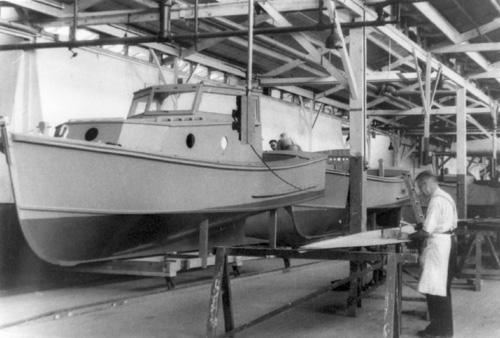
26' Motor Dories under construction at General Motors - Holdens
Woodville Plant, Adelaide.
Photo: DSTO Webpage (now no longer
viewable)

The 26' Motor Dory frame was built upside down. Photo: State Library of South Australia

The background shows the hulls being laminated with two layers of plywood strips. The foreground appear to show jigs for bending the plywood strips. Photo: State Library of South Australia. [Any comments that can better interpret the photo would be appreciated].

Completed 26' Motor Dories USA D No.346 and USA D No.347, plus two others, berthed at Port Adelaide after having been launched. Photo: State Library of South Australia
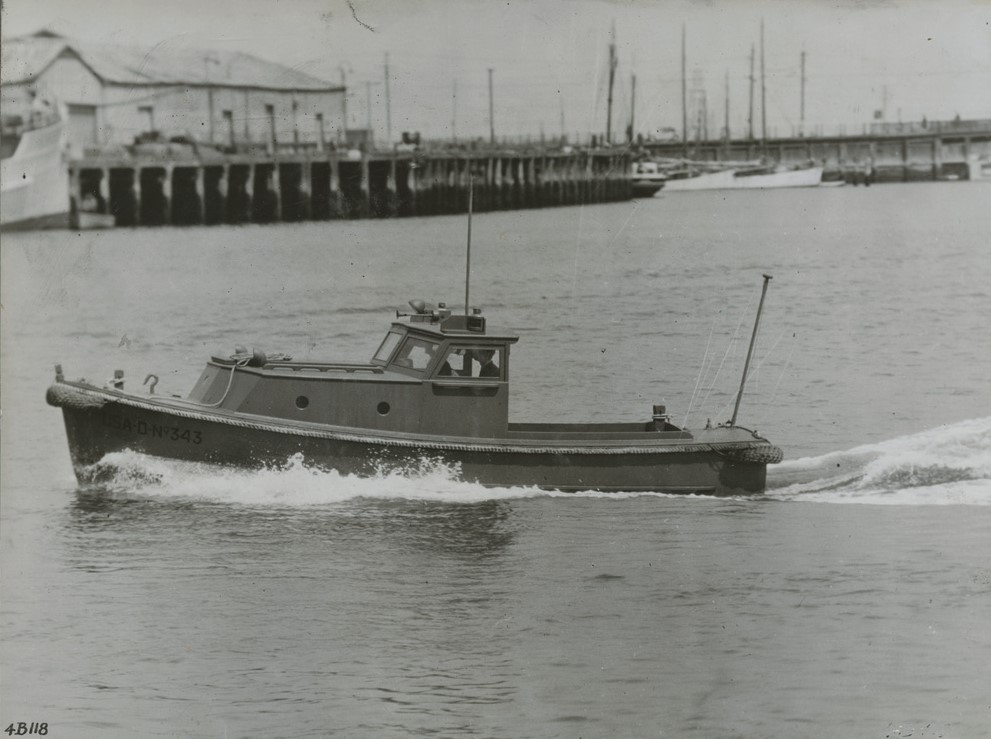
26' Motor Dory USA D No.343, probably running trials at Port Adelaide. Photo: State Library of South Australia
Slazengers (Australia) Pty Ltd
Slazengers were the well-known manufacturers of
tennis racquets, having their factory at Alexandria. Any company and,
indeed, anyone with skills in woodworking was sought to participate in
the small craft program. Tennis racquets of the day were made of
laminated timber, and Slazengers were also familiar with mass production
techniques. With a factory remote from the water at Alexandria, the
company's earlier production was for small craft. These included the 26'
motor dories, 36' wooden landing barges for the US Army, and launches for the Royal
Australian Air Force.
In January 1943 Slazengers leased a waterfront
site at Putney for building larger craft that included six 56' motorised scows at that waterfront site.

The Slazenger Boatyard Annex at Alexandria in about 1945. Photo:
State Library of NSW
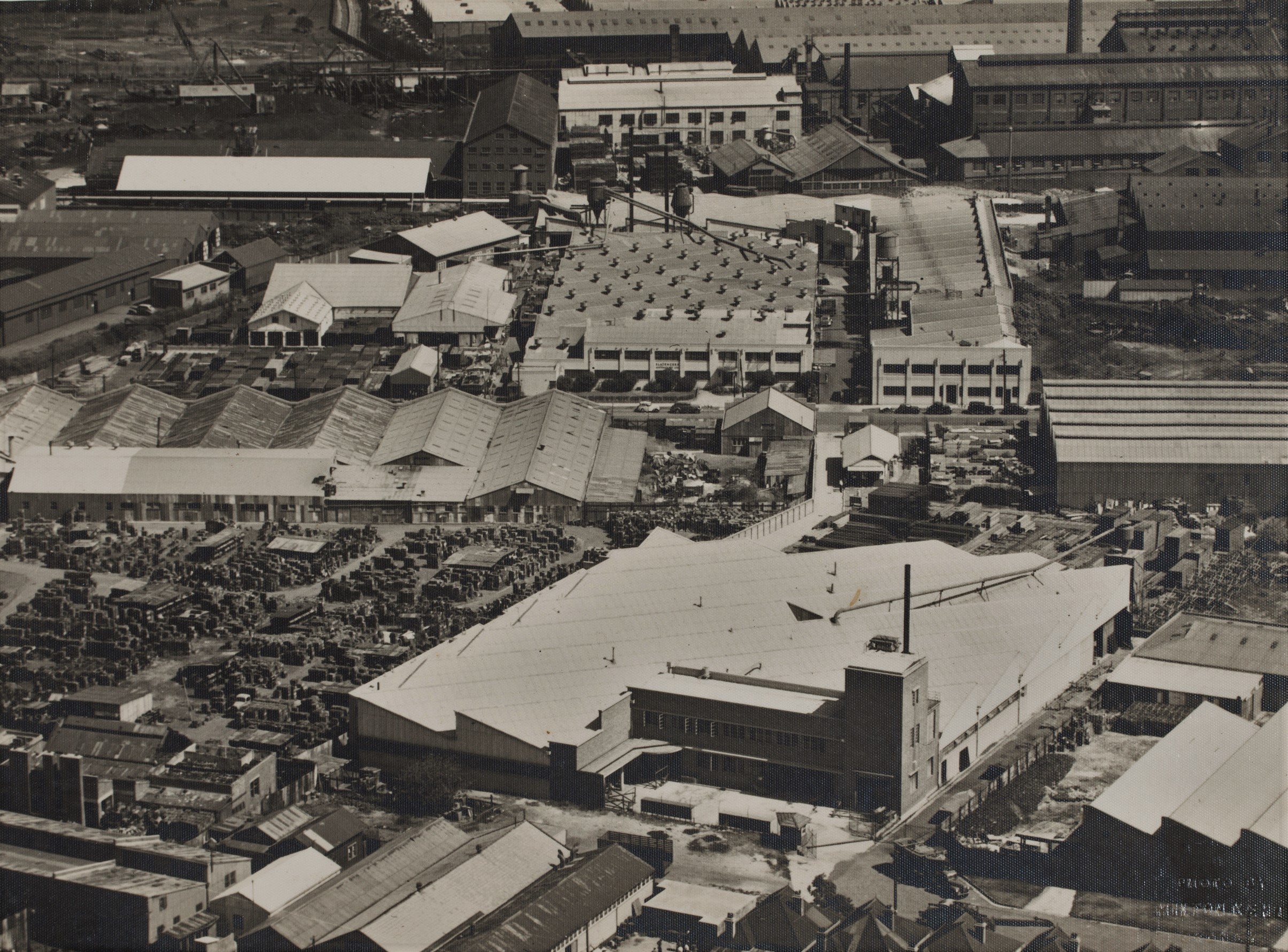
Slazengers Alexandria Factory during World War II. Photo: State Library of NSW
_Slazenger_CamFinlay_01.jpg)
See caption below
_Slazenger_CamFinlay_02.jpg)
_Slazenger_CamFinlay_03.jpg)
26' Motor Dories under construction at the Slazenger Annex,
Alexandria.
This contemporary caption above applies to the two photos
above it. Photos: Cam Finlay

Twenty-two 26' Slazenger-built motor dories ready for delivery to the US
Army.
Photo: Author's collection
How many 26' motor dories were built?
No definitive answer has so far been
found for this question, but probably multiple hundreds. Indications
are that by far the majority were built for the US Army Small Ships.
A smaller number were built for the Australian Army and the Royal
Australian Navy. At the end of the war, there was also a batch under
construction for the Royal Navy.
References indicate that a
total of 46 Motor Dories were ordered for the Australian Army that
included 26 hulls taken over incomplete from surplus US production at
Slazengers, as well as 20 craft ordered from General Motors in
Adelaide. The first was delivered to the Australian Army in
1944. 28 were eventually to see Army service. By March 1945, 19 had
been delivered. By late September 1945 there were 25 in service. Known
identifying numbers for these are:
AM1702 to AM1721 (20 motor
dories)
AM 2725 to AM2729 (5 motor dories)
The report that
follows shows the status of 26' Motor Dory construction as at
September 1945.
|
A |
Standard Type No. |
18 |
|
||
|
B |
Type of craft |
26’ Motor Dory |
|
||
|
C |
Service Requiring |
Aust.
Army |
Royal
Aust. Navy |
Royal
Navy |
TOTALS |
|
D |
Orders raised by services |
46 |
36 |
100 |
182 |
|
E |
Cancellations to date |
18 |
9 |
47 |
74 |
|
F |
Requirement as at 30/9/45 |
28 |
27 |
53 |
108 |
|
G |
Delivered
included in D & F |
25 |
26 |
10 |
61 |
|
H |
Under construction included in D & F |
3 |
3 |
43 |
49 |
|
I |
Reduction in requirement since 30/6/45 |
0 |
9 |
47 |
56 |
Engines
The motor dories were fitted with a range of
engines. Petrol engines were most common, probably owing to the shortage
of diesels.
The records record the following engines in the 26'
Motor Dories:
102-143bhp 8Cy. Chrysler Royal petrol (Cyls. 3⁷⁄16"-4½")
76-110bhp 6Cy. Chrysler Crown petrol (Cyls. 3⁷⁄16"-4½")
95bhp V8Cy. Vosper Ford Mark III marine petrol (Cyls. 3³⁄16"-3¾")
95bhp V8Cy. Parsons Ford petrol
130bhp 6Cy. Perkins S6M marine diesel
Postwar deployment
With the cessation of hostilities in August 1945, the Small Craft building program was reviewed. Construction continued for a period to complete boats that were well advanced. When the Small Craft Program ended early in 1946, there were boats that had been completed but not delivered, and boats that were at various stages of construction. In addition there were boats that were now surplus to the requirements of the armed services. The Commonwealth Disposals Commission was established to dispose of war surplus. Before vessels were offered for sale, they were offered to the other services and Government Departments..Twenty of the dories that were deemed surplus to the Australian Army were transferred to the Royal Australian Navy. A handful were believed to have been kept by the Army after the war.
Those that remained unallocated were to be sold. But before they were offered to the general public at large, the war surplus boats were offered for purchase to ex.servicemen in recognition of their sacrifices and to support their integration back into the peacetime economy.
What was left was put up for auction by the Commonwealth Disposals Commission. A selection of articles and advertisements follow:
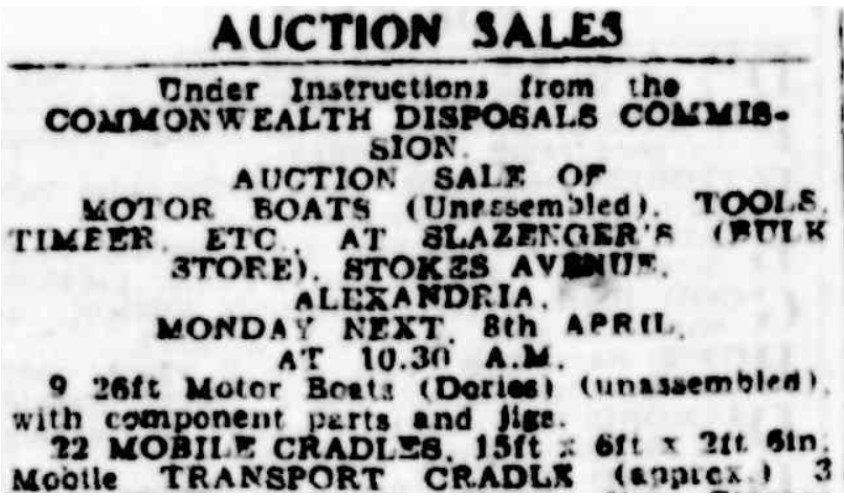
Sydney Morning Herald 3 April 1946
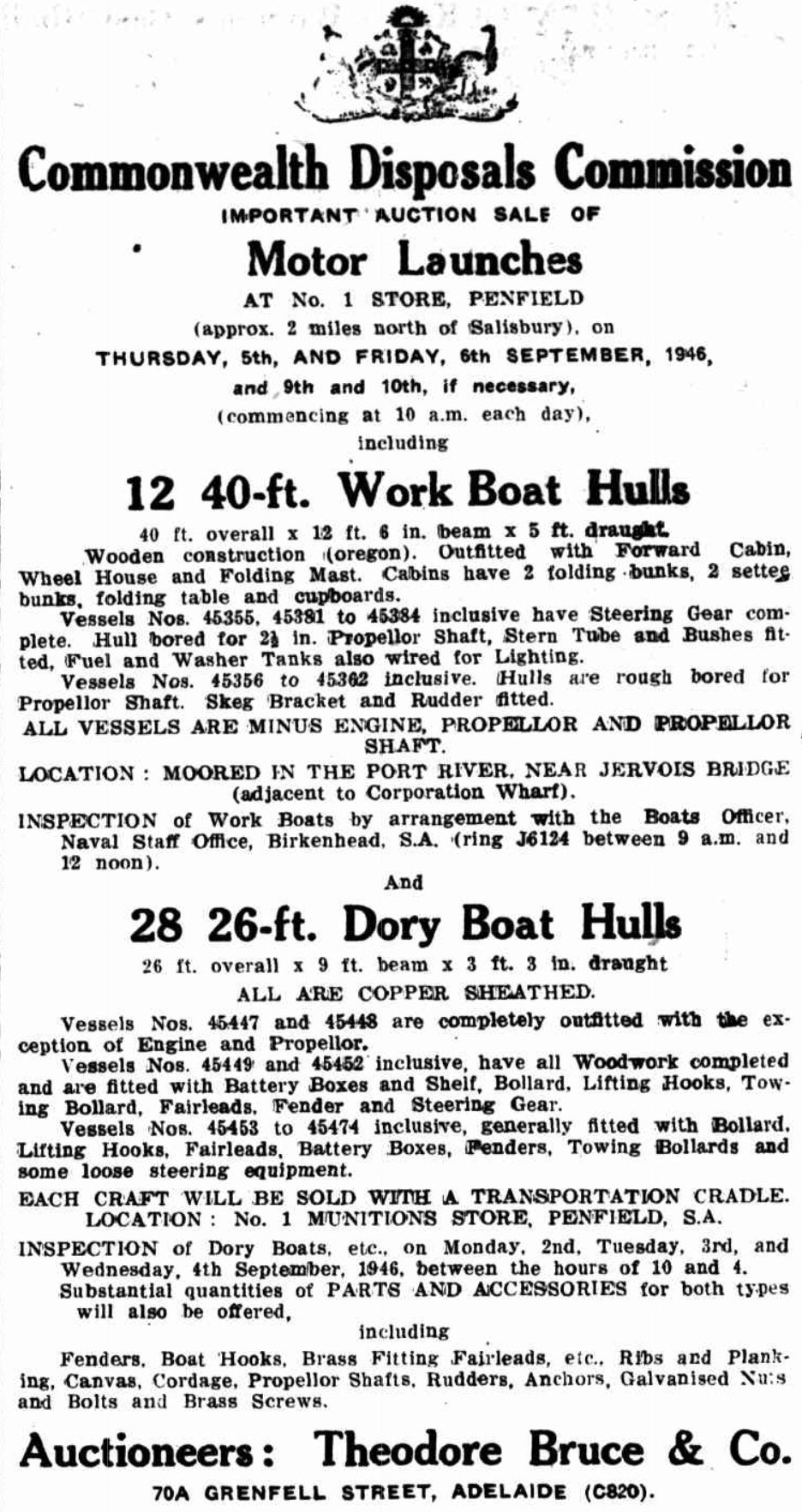
Port Lincoln Times 29 Aug 1946
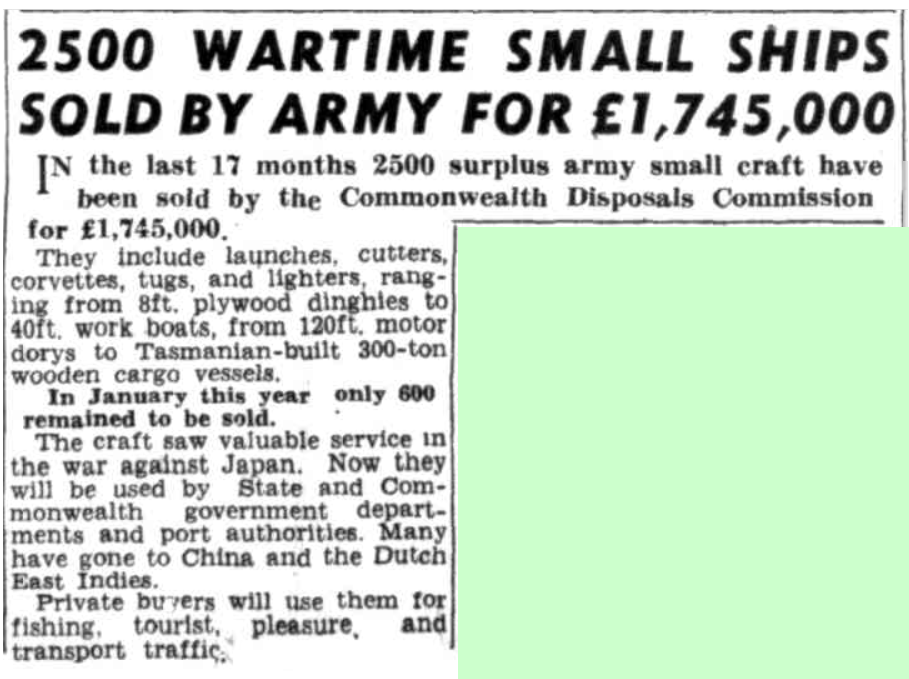
Sunday Mail 18 May 1947
Twenty five of the 26'
Motor Dories were operated the RAN after World War 2. These may well
have included the 20 former Australian Army dories as the RAN's DR16 was
previously the Australian Army's AM1708..
By January 1947,
fifteen of the Motor Dories were being operated by the RAN with
identifying numbers DR1 to DR16. The status of DR4 at that time was
unknown. Their deployment was as shown in the table below..
| DesignationDesignation | Deployment of RAN 26' Motor Launches in Jan 1947 |
| DR1 | FOIC Sydney. |
| DR2 | FOIC Sydney, attached to Engineering Manager. |
| DR3 | NOIC New Guinea, allocated to Tarangau. |
| DR4 | [no information] |
| DR5 | FOIC Sydney, attached to C.D. for disposal section. |
| DR6 | FOIC Sydney, attached to C.D. |
| DR7 | Under control of NOIC Darwin. |
| DR8 | Under control of NOIC Darwin |
| DR9 | NOIC Brisbane, allocated to Small Craft Base |
| DR10 | FOIC Sydney, attached to Commanding Officer Reserve Ships |
| DR11 | NOIC Brisbane |
| DR12 | FOIC Sydney, attached to C.D. |
| DR13 | FOIC Sydney, attached to N.O.I. Officer |
| DR14 | FOIC Sydney, attached to S.N.S.O. |
| DR15 | NOIC Brisbane, allocated to HMAS Moreton depot |
| DR16 | Under control of NOIC Darwin |
The RAN continued to operate the Motor Dories through the 1950s and 1960s. Most were no longer in use by the 1970s. They appear to have been sold off.
+DR5(c1944)+Unidentified+Motor+Dory_1959_GardenIsland_GeorgeHicks_Gid1.jpg)
DR6 and DR5 and an unidentified Motor Dory (right) on hardstand at Garden Island in 1959. Photo: George Hicks, Garden Island Dockyard Facebook Group
_c1963_Sydney_MiltonCotterell_Shh1.jpg)
Though in 1947 DR3 was assigned to Tarangau,
New Guinea, by the early 1960s, she in Sydney mostly on standby at "Ships
in Reserve" at Athol Bight, Sydney. Photo: Milton Cotterell
Current status
It has been now almost 80 years since the 26'
Motor Dories were built. Intended for the immediate needs of war,
longevity was not a high priority.
Leyland Wilkinson recalled:
Most were built at Slazengers boatyard at Putney[sic] around 1943 using laminated plywood which de laminated over the years. I was aboard one about 1960 when we hit a mooring bouy in the harbour that poked a nasty hole in the bow!
Jeffro Da Hodge wrote:I believe the workboat at Burraneer Bay Marina may be one of these, George may be the name.
Despite the odds, a few of the 26' Motor Dories
survive with scant knowledge of their history.
Seagull - AM17100
Still in a very original configuration, the
Seagull was originally the AM1710 operated by the Australian Army. Her
history up until 2020 is yet to be revealed. However, by 2020 she was for
sale at Seaforth. Her new owner in 2022 is very keen to find out more
about her story. Photoo belo: Luke Westonn
_RobertParker_2019.jpg)
Wirake
Wirake is still on Sydney Harbour. She provides an
example of a motor dory that has been modified as a pleasure cruiser.
Again, her early history is unknown but it is believed that she was one of
the dories operated by the RAN. Further information on Wirake can be found
on the webpage http://www.boatregister.net/Wirake.htmm
Photos below: Eduard McPeake
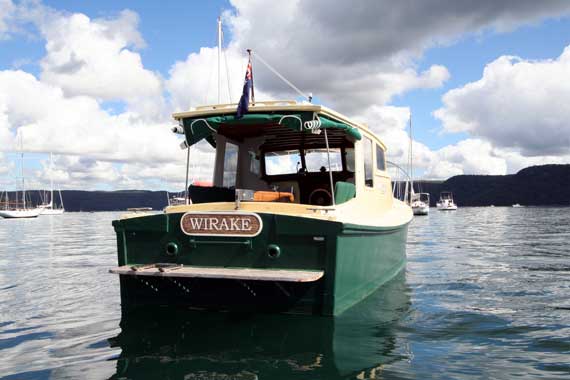

_______________________________________________________________________
Acknowledgements: The author would like to thank the following contributors to this web page:
Ross Gillett, State Library of NSW, State Library of
South Australia, National Library of Australia, National Archives of
Australia, Cam Finlay, Leyland Wilkinson, Jeffro Da Hodge, Luke Weston,
Eduard McPeake
_______________________________________________________________________
If you have an interest in participating in a forum to share information and knowledge about
26' motor dories, other service boats during WW2, and boats that were requisitioned during
the War, then you might like to join TBA:
Created: 31 May 2022
Updated: 1 June 2022
